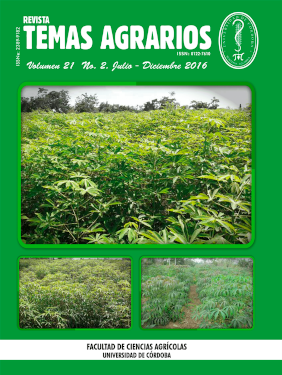Eeffect of noncaloric sweeteners on the development of blackberry (Rubus glaucus Benth) jam
Efecto de edulcorantes no calóricos sobre el desarrollo de mermelada de mora (Rubus glaucus Benth)

This work is licensed under a Creative Commons Attribution-NonCommercial 4.0 International License.
Show authors biography
low calorie blackberry jams (Rubus glaucus Benth) were developed using non-caloric sweeteners. An experimental randomized complete block design with 6 treatments and 4 replicates was used. pH, acidity, total soluble solids (TSS), texture, browning index (BI) and organoleptic characteristics were evaluated, the caloric content was calculated for each treatment. The methodology followed the Colombian Technical Standard (NTC 285). Jams with sucrose and pectin served as control, whereas treatments were made with stevia and sucralose and agar - agar as gelling. The pH of treatments presented a value below the minimum established by the standard NTC 285 and also the acidity. The TSS control were consistent with those recommended by the CODEX STAN 296-2009. For all treatments with non-caloric sweeteners and combinations the TSS were lower compared to the control; the texture presented no significant difference between treatments and control with a confidence level of 95%, sensory analysis for treatments sucrose and stevia (t4) and sucrose and sucralose (t)5 showed greater acceptance and no significant differences with the control. The caloric reduction was 91.03%, 91.02%, sucralose 90.90%, for treatments stevia (t3), stevia and sucralose (t6), and sucralose (t2), respectively, relative to control. The study concluded that the t2, t3 and t6 treatments are low-calorie products and that t5 and t4 were the most widely accepted.
Article visits 3171 | PDF visits
Downloads
- Garrido, J., Lozano, J., y Genovese, D. 2015. Effect of formulation variables onrheology, texture, colour, and acceptability of apple jelly: Modelling and optimization. LWT - Food Science and Technology 62(1): 325-332.
- ICONTEC (El Instituto Colombiano de Normas Técnicas y Certificación). 1996.Arequipe o dulce de leche. ICONTEC (NTC 3757), 9p.
- ICONTEC. 1997. Frutas frescas – mora de castilla (Rubus glaucus Benth). ICONTEC(NTC 4106), 13p.
- ICONTEC. 2002. Helados y mezclas de helados. ICONTEC (NTC 1239), 18p.
- ICONTEC. 2007. Frutas procesadas, mermeladas y jalea de frutas. ICONTEC (NTC285), 11p.
- Jiménez, D., Cock, J., Satizábal, H., Barreto S., Pérez, A., Jarvis, A. And Damme,P. 2009. Analysis of andean blackberry (Rubus glaucus) production modelsobtained by means of artificial neural networks exploiting information collectedby small-scale growers in Colombia and publicly available meteorological data.Computers and Electronics in Agriculture 69(2): 198-208.
- Kmazurkiewicz, J., Rebilas, K. And Tomasik, P. 2006. Dextran-low-molecularsaccharide sweetener interactions in aqueous solutions. Food HydrocolloidsJanuary 20(1): 21-23.
- Kubota, M., Ishikawa, C., Sugiyama, Y., Fukumoto, S., Miyagi, T. And Kumazawa, S. 2012. Anthocyanins from the fruits of rubus croceacanthus and rubus sieboldii, wild berry plants from Okinawa, Japan. Journal of Food Composition and Analysis 28(2): 179-182.
- Maldonado, S. y Singh, C. 2008. Efecto de gelificantes en la formulación de dulce de yacón. Ciência E Tecnologia de Alimentos 28(2): 429-434.
- Manayay, D. y Ibarz, A. 2010. Modelamiento de la cinética de reacciones del pardeamiento no enzimático y el comportamiento reológico, en el proceso térmico de jugos y pulpas de fruta. Scientia Agropecuaria 1(2):155-168.
- Mascan, M. 2001. Kinetic of colour of kiwi fruits during hot air and microwave drying. Journal of Food Engineering 48(2): 169-175.
- OMS (Organización Mundial de la Salud) y FAO (Organización de las
- Naciones Unidas para la alimentación y la agricultura). 2009.
- Norma del Codex para la confitura, jaleas y mermeladas. (CODEX STAN 296), 10p.
- Rios, V., Pimienta, P., Marques, A., Oliveira, L., Pio, R. And Queiroz, F. 2014. Analysis of the subtropical blackberry cultivar potential in jelly processing. Journal of Food Science 79(9): 1776s-1781s.
- Vera, M. 2012. Elaboración de mermelada light de durazno. Tesis en Ingeniero enAlimentos. Universidad de Chile, Santiango de Chile.
- Watts, B., Ylimaki, G., y Jeffery, L. 1992. Métodos sensoriales básicos para la evaluación de alimentos. Centro Internacional de Investigaciones para el Desarrollo (CIID), Ottawa, p70-85, p132.




















